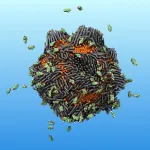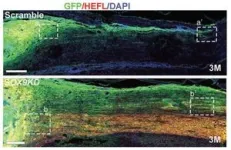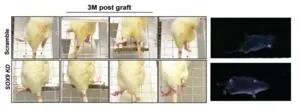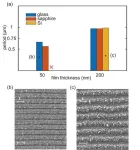(Press-News.org) SAN FRANCISCO, Aug. 16, 2023 — Pouring flecks of rust into water usually makes it dirtier. But researchers have developed special iron oxide nanoparticles they call “smart rust” that actually makes it cleaner. Smart rust can attract many substances, including oil, nano- and microplastics, as well as the herbicide glyphosate, depending on the particles’ coating. And because the nanoparticles are magnetic, they can easily be removed from water with a magnet along with the pollutants. Now, the team is reporting that they’ve tweaked the particles to trap estrogen hormones that are potentially harmful to aquatic life.
The researchers will present their results today at the fall meeting of the American Chemical Society (ACS). ACS Fall 2023 is a hybrid meeting being held virtually and in-person Aug. 13–17, and features about 12,000 presentations on a wide range of science topics.
A video on the research is available at www.acs.org/SmartRust.
“Our ‘smart rust’ is cheap, nontoxic and recyclable,” says Marcus Halik, Ph.D., the project’s principal investigator. “And we have demonstrated its use for all kinds of contaminants, showing the potential for this technique to improve water treatment dramatically.”
For many years, Halik’s research team has been investigating environmentally friendly ways to remove pollutants from water. The base materials they use are iron oxide nanoparticles in a superparamagnetic form, which means they are drawn to magnets, but not to each other, so the particles don’t clump.
To make them “smart,” the team developed a technique to attach phosphonic acid molecules onto the nanometer-sized spheres. “After we add a layer of the molecules to the iron oxide cores, they look like hairs sticking out of these particles’ surfaces,” says Halik, who is at Friedrich-Alexander-Universität Erlangen-Nürnberg. Then, by changing what is bound to the other side of the phosphonic acids, the researchers can tune the properties of the nanoparticles’ surfaces to strongly adsorb different types of pollutants.
Early versions of smart rust trapped crude oil from water collected from the Mediterranean Sea and glyphosate from pond water collected near the researchers’ university. Additionally, the team demonstrated that smart rust could remove nano- and microplastics added to lab and river water samples.
So far, the team has targeted pollutants present in mostly large amounts. Lukas Müller, a graduate student who’s presenting new work at the meeting, wanted to know if he could modify the rust nanoparticles to attract trace contaminants, such as hormones. When some of our body’s hormones are excreted, they are flushed into wastewater and eventually enter waterways. Natural and synthetic estrogens are one such group of hormones, and the main sources of these contaminants include waste from humans and livestock. The amounts of estrogens are very low in the environment, says Müller, so they are difficult to remove. Yet even these levels have been shown to affect the metabolism and reproduction of some plants and animals, although the effects of low levels of these compounds on humans over long periods aren’t fully known.
“I started with the most common estrogen, estradiol, and then four other derivatives that share similar molecular structures,” says Müller. Estrogen molecules have a bulky steroid body and parts with slight negative charges. To exploit both characteristics, he coated iron oxide nanoparticles with two sets of compounds: one that’s long and another that’s positively charged. The two molecules organized themselves on the nanoparticles’ surface, and the researchers hypothesize that together, they build many billions of “pockets” that draw in the estradiol and trap it in place.
Because these pockets are invisible to the naked eye, Müller has been using high-tech instruments to verify that these estrogen-trapping pockets exist. Preliminary results show efficient extraction of the hormones from lab samples, but the researchers need to look at additional experiments from solid-state nuclear magnetic resonance spectroscopy and small-angle neutron scattering to verify the pocket hypothesis. “We are trying to use different puzzle pieces to understand how the molecules actually assemble on the nanoparticles’ surface,” explains Müller.
In the future, the team will test these particles on real-world water samples and determine the number of times that they can be reused. Because each nanoparticle has a high surface area with lots of pockets, the researchers say that they should be able to remove estrogens from multiple water samples, thereby reducing the cost per cleaning. “By repeatedly recycling these particles, the material impact from this water treatment method could become very small,” concludes Halik.
The researchers acknowledge support and funding from the German Research Foundation, the German Federal Environmental Foundation and Friedrich-Alexander-Universität Erlangen-Nürnberg.
A recorded media briefing on this topic will be posted Wednesday, Aug. 16, by 10 a.m. Eastern time at www.acs.org/acsfall2023briefings. Reporters can request access to media briefings during the embargo period by contacting newsroom@acs.org.
For health and safety information for ACS Fall 2023, please visit the FAQ webpage.
The American Chemical Society (ACS) is a nonprofit organization chartered by the U.S. Congress. ACS’ mission is to advance the broader chemistry enterprise and its practitioners for the benefit of Earth and all its people. The Society is a global leader in promoting excellence in science education and providing access to chemistry-related information and research through its multiple research solutions, peer-reviewed journals, scientific conferences, eBooks and weekly news periodical Chemical & Engineering News. ACS journals are among the most cited, most trusted and most read within the scientific literature; however, ACS itself does not conduct chemical research. As a leader in scientific information solutions, its CAS division partners with global innovators to accelerate breakthroughs by curating, connecting and analyzing the world’s scientific knowledge. ACS’ main offices are in Washington, D.C., and Columbus, Ohio.
To automatically receive press releases from the American Chemical Society, contact newsroom@acs.org.
Note to journalists: Please report that this research was presented at a meeting of the American Chemical Society.
Follow us: Twitter | Facebook | LinkedIn | Instagram
Title
Smart rust to clean water from hormones
Abstract
Access to clean water is recognized as a human right by the United Nations. However, anthropogenic molecular pollutants, like hormones are present in our ground water and find their way into drinking water due to careless disposal and insufficient remediation. Already at the trace concentration level such compounds have been shown to have severe effects on aquatic flora and fauna, but also to us humans, especially children. Still consequences of long term exposure are often unknown. Therefore, it exists a big demand in affordable and efficient removal of such organic contaminants from water. Having this in mind, we are en route to develop a promising concept to solve this problem. Superparamagnetic iron oxide nanoparticles (SPIONs) are surface-functionalized with self-assembled monolayers (SAMs) composed of permanently binding phosphonic acid derivates to address certain interaction motifs of selected hormones (“smart rust”). Such particles attract the pollutants and can be easily remediated from water by an external magnetic field due to the magnetic moment of its cores. Basing on previous successful remediation of the herbicide glyphosate, micro- and nanoplastics as well as crude oil via single major interaction motifs (covalent binding – electrostatic interactions – hydrophobic interaction respectively), we pursue the next logical step. We establish the interaction of rationally designed mixed SAMs on SPIONs with dedicated trace organic pollutants, i. e. various estrogen derivates. Therefore, we envision sorbent systems that are not only thermodynamically attractive for the pollutants of choice by combination of multiple interaction motifs, but also present suitably-sized cavities in the mixed SAM. This approach benefits from synergy of experimental materials science and analytical chemistry to tailor hybrid nanoparticles.
END
Cleaning water with ‘smart rust’ and magnets (video)
2023-08-16
ELSE PRESS RELEASES FROM THIS DATE:
Tubing and swimming change the chemistry and microbiome of streams
2023-08-16
SAN FRANCISCO, Aug. 16, 2023 — With Labor Day approaching, many people are preparing to go tubing and swimming at local streams and rivers. These delightful summertime activities seem innocuous, but do they have an impact on these waterways? Today, scientists report preliminary results from the first holistic study of this question, which shows that recreation can alter the chemical and microbial fingerprint of streams, but the environmental and health ramifications are not yet known.
The researchers will present their results at the fall meeting of the American Chemical Society (ACS). ACS Fall 2023 is a hybrid meeting ...
Experiencing pain after a heart attack may predict long-term survival
2023-08-16
Research Highlights:
Experiencing pain – even pain not associated with heart disease – a year after having a heart attack is common, and people who had moderate or extreme pain were more likely to die within the next 8 years compared to adults who did not have any post-heart attack pain.
When recommending treatment and making prognoses for people who have had a heart attack, health care professionals should consider if the patients are experiencing moderate or extreme pain.
Embargoed until 4 a.m. CT/5 a.m. ET Wednesday, Aug. 16, 2023
DALLAS, ...
Racism, poverty, and illiteracy increase the risk of contracting and succumbing to AIDS in Brazil
2023-08-16
Social determinants of health —the social conditions in which people grow up, live and work— can influence the risk of contracting AIDS and the mortality associated with the disease. This is the main conclusion of a new study carried out by the Barcelona Institute for Global Health (ISGlobal), a centre supported by the "la Caixa" Foundation, and published in The Lancet Regional Health.
The research team evaluated a cohort of 28.3 million people, representative of the low-income Brazilian population, based on data collected between 2007 and 2015. This is the largest evaluation of social determinants of health ...
Harnessing big data reveals birds’ coexisting tactics
2023-08-16
Birds likely hold smart insights about coexisting in popular habitats– especially as climate change looms. But tapping into that knowledge has a big hurdle: knowing where and how numerous birds live successfully in vast environments.
In today’s biological research journal Proceedings of the Royal Society B, scientists at Michigan State University (MSU) peeled back layer upon layer of big data to tease out real-life answers that until now have been explored mostly in small-scale experiments.
Sam Ayebare, a PhD candidate from Uganda, has led the work that is the first steps to understanding how so many birds can coexist in the vast Albertine ...
Six strategies could boost NY City housing by 300,000 units over decade
2023-08-16
Six policies aimed boosting residential housing construction in New York City could spark the production of roughly 300,000 additional new housing units over a decade, according to a new RAND Corporation report.
The additional housing units would represent more than a 160% increase over recent annual housing production levels in the city, according to the report.
Researchers say the surge in housing supply likely would lead to increased affordability through greater competition among landlords for tenants in the short term and an increase in naturally occurring ...
The Journal of Scientific Exploration publishes special issue on the Shakespeare authorship question
2023-08-16
In the issue, ten historians and literary scholars present evidence that casts serious doubts about who actually authored the monumental works credited to William Shakespeare. Suggesting that the name is actually a pseudonym for someone else, this position has been endorsed by numerous artists and scholars over the decades ranging from Walt Whitman and Mark Twain to Sigmund Freud, Tyrone Guthrie (founder of Canada’s Stratford Shakespeare Festival) and Mark Rylance founding Artistic Director of the reconstructed Globe Theatre in London.
Tradition credits a businessman from an essentially ...
In-school occupational therapy creates positive education experiences for kids with autism
2023-08-16
Strong parent-school relationships are central to a child’s learning, development, and wellbeing, yet when it comes to children with autism (ASD), it seems positive relationships are few and far between say UniSA researchers.
In Australia, an estimated 200,000 people are autistic, with autism the largest primary disability group served by the NDIS. Globally, about one in 100 children are autistic.
Lead researcher, UniSA’s Dr Kobie Boshoff, says support is urgently needed in schools to support the learning needs of children with ...
Team compares reanalysis datasets with Advanced Himawari Imager measurements over East Asia
2023-08-16
Today’s weather satellites provide scientists with a unique opportunity to evaluate the abilities of various reanalysis datasets to depict multilayer tropospheric water vapor. So a research team undertook a study to assess multilayer water vapor depiction in six representative reanalysis datasets against the measurements from the Advanced Himawari Imager over East Asia. Because water vapor is important in the formation of clouds and precipitation, it is vital for scientists to better understand water vapor and the biases among various datasets.
Their work is published in the journal Advances in Atmospheric Science on July 29, 2023.
Scientists produce reanalysis datasets when ...
Controlling the source of electromagnetic waves enables control of the period of laser-induced periodic surface structures (LIPSS)
2023-08-16
Since the scientists at Bell Labs invented the world’s first transistor in December 1947, a revolution in microelectronics technology has profoundly affected lifestyles worldwide. As electronics get smaller and smaller, it is a challenge to find an easy, fast, and low-cost way to fabricate micro-nano components. Traditional direct writing fabrication methods such as mechanical scribing, focused ion beam etching, electron beam lithography, multiphoton polymerization, and thermal scanning probe etching are inefficient. Although methods such as nanoimprinting, photolithography, plasma etching, and ...
Immigration slowed in COVID-19 pandemic, but migrant jobs not filled by U.S.-born
2023-08-16
A prevailing narrative about immigration is that migrants displace U.S.-born residents in the workforce, but new research from University of California, Davis, economists shows that’s not the case.
The study, published in the Journal of Population Economics, details how the COVID-19 pandemic led to a decrease in immigration to the U.S. and how jobs often filled by migrants were not filled by U.S.-born residents.
“We found that this drop in immigrants corresponded also to a drop in employment in some specific types of occupations, including accommodation ...





